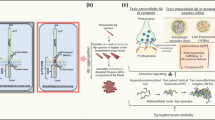Abstract.
Despite an exponential production of data, Alzheimer's disease (AD) remains an enigma. Unresolved questions persist in the face of the heterogeneity of this neuropathology. Recent progress in understanding mechanisms for AD results from the study of amyloid precursor protein (APP) metabolism and the involvement of senile plaque-associated proteins. In addition to the amyloid cascade hypothesis, alternative schemes emerge, in which the amyloid peptide is not the primary effector of the disease. Perturbations of vesicular trafficking, the cytoskeletal network, and membrane cholesterol distribution could be central events. Furthermore, since the physiological role of APP, presenilins, and apolipoprotein E in the central nervous system are not completely understood, their involvement in AD etiology remains speculative. New actors have to be found to try to explain sporadic cases and non-elucidated familial cases.
Similar content being viewed by others
Author information
Authors and Affiliations
Rights and permissions
About this article
Cite this article
Drouet, B., Pinçon-Raymond, M., Chambaz*, J. et al. Molecular basis of Alzheimer's disease . CMLS, Cell. Mol. Life Sci. 57, 705–715 (2000). https://doi.org/10.1007/s000180050035
Issue Date:
DOI: https://doi.org/10.1007/s000180050035




